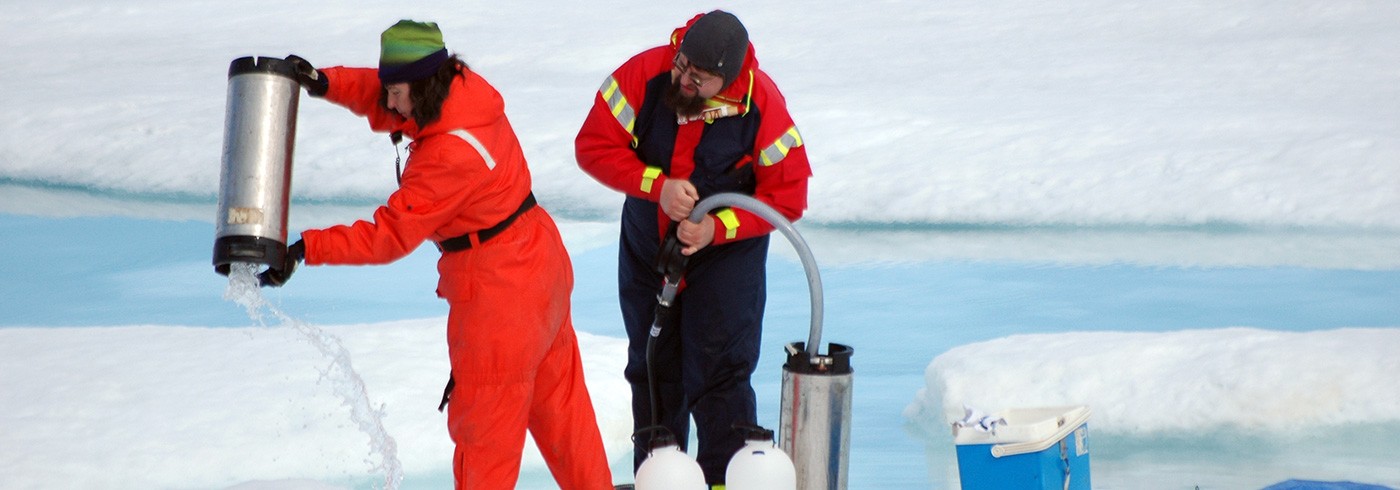Sources of methane and nitrous oxide to the coastal Arctic Ocean
5 July 2005 - 31 July 2005
Methane (% saturation, circles and black line) and Sea Surface Temperature (°C, grey line) against latitude. These data were collected along the Beringia 2005 leg 1 cruise track between July 14th and July 16th in Baffin Bay. The Marginal Ice Zone front (MIZ, evidenced by the sharp decrease in temperature) is marked.
Rationale
Methane (CH4) is a climatically active trace gas, emitted to the atmosphere from the marine environment. Methane is a greenhouse gas and further participates in tropospheric ozone regulation, indirectly controlling the ‘self-cleaning capacity’ of the atmosphere by removing hydroxyl radicals (•OH) (Crutzen, 1991). Due to source-sink imbalances tropospheric CH4 has doubled during the past 200 years. This increase accounts for ~15% of the net heating perturbation since the 1800s.
Glacial-interglacial covariance of CH4 and temperature (Ehhalt et al., 2001, Dlugokencky et al., 1994) reveals a potential role for CH4 in climate shifts (Nisbet 1992, Kennett et al., 2000), and one region in which this link may involve strong feedbacks is the Arctic (Ehhalt et al., 2001). Potential sources of CH4 include riverborne inputs from sediments (thermogenic and biogenic) as well as the water column biogenic production, while sea–air exchange and microbial processes act as sinks. There is a considerable lack of evidence on the relative strength of these sources and sinks in the Arctic Ocean, therefore our overall objective was to collect preliminary data on CH4 distribution and dynamics in Arctic waters during leg 1 of Beringia 2005 (Göteborg, Sweden to Barrow, Alaska, USA). This has led to successful international collaboration between Göteborg and Newcastle Universities, the Swedish Polar Research Secretariat and the UK Natural Environment Research Council, which funded this study. Given the context of this work in the wider ‘carbon cycling’ project led by Prof. L. Anderson, we anticipate the results of this study to carry added value for the scientific community as well as for decision-making bodies.
Specific aims
- To determine CH4 concentrations in surface seawater, in water column profiles and in air during leg 1 of Beringia 2005.
- To identify potential sources and sinks of CH4 by determining:
- the associated δ13C isotopic signatures of dissolved-CH4 (thermogenic CH4 has enriched 13C isotope abundance compared to biogenic CH4),
- bacterial abundance and
- dissolved silicate concentration (as a tracer of freshwater inputs from rivers).
- To estimate sea-to-air CH4 fluxes based on gas transfer models and to provide preliminary yet highly novel information on the CH4 budget of the Arctic Ocean and its potential role in climate change.
Fieldwork description
Dissolved CH4 and N2O in surface seawater were determined in 154 samples by gas chromatography following headspace equilibration according to established techniques (Upstill-Goddard et al., 1996). In order to distinguish between thermogenic and biogenic sources of methane we collected 40 seawater samples for the determination of their δ13C isotopic signatures of dissolved CH4. In addition we collected 28 samples for bacterial enumeration as an indicator of bacterial abundance and a further 62 samples for the determination of silicate in seawater as a tracer of river inputs. In addition we carried out a limited number of opportunistic incubations of seawater, sea ice, melt water and snow in order to ascertain the potential for biogenic CH4 production from these environments.
Preliminary results
The stable isotope, bacterial and silicate samples were transferred to our laboratory in Newcastle for pending analysis. Our preliminary results are therefore limited to underway surface seawaterdissolved CH4 concentrations, determined onboard the icebreaker Oden.
We found large variations (up to fourfold) in surface-dissolved CH4 along the Beringia 2005 leg 1 cruise track. Surface seawater was thus undersaturated in places and oversaturated in others with respect to equilibrium with the atmosphere. (Dissolved CH4 is here expressed as % saturation with respect to atmospheric equilibrium, i.e. at 100%, CH4 will come out of solution and vent to the atmosphere.) Figure 1 shows data from a section of Baffin Bay along the Beringia 2005 leg 1 cruise track. This figure highlights the spatial heterogeneity of the distribution of dissolved CH4 along the cruise track, possibly reflecting the dynamic nature of CH4 cycling in the Arctic Ocean compared to other oceans at lower latitude. This is likely linked to ice conditions. Temporal and seasonal variability in ice conditions may act as a seal for sea–air exchange of dissolved gases as well as provide an ever-changing substrate for biological activity, thereby creating ‘patchiness’ in the distribution of dissolved CH4. This link can be seen in Figure 1 as high dissolved CH4 saturation associated with the Marginal Ice Zone (MIZ, latitude 58- 61°W). This is a highly productive environment where increased biological activity likely leads to biogenic CH4 production and hence elevated saturation in seawater. Further high methane saturation between 62°W and 65°W is likely due to restricted sea–air exchange under consolidated pack ice and therefore accumulation of CH4.

